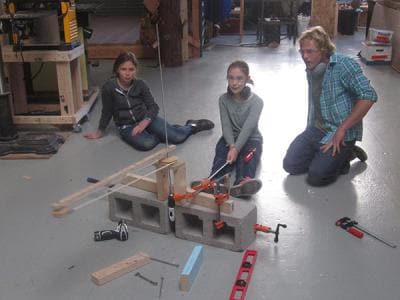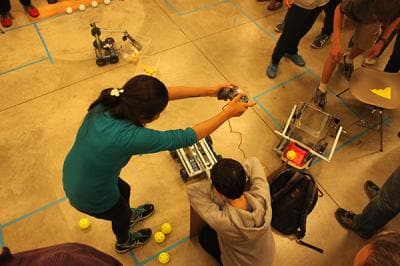This post was originally published on Metropolis Magazine's POV Blog.
Stop. Put down your pencils and take a break from angst over endless test preparations to consider how design thinking may help schools shed the “rat race” of teaching to the tests. Standardized testing has manifested a pressure cooker atmosphere with a learn-memorize-test approach. Public schools are forced to conform in order to get federal funding and even independent schools are test driven due of the heavy reliance on SAT and ACT scores for college admissions.
A movement to “think again” about this self-perpetuating system is gaining momentum. As a parent, I know that this model doesn’t take into consideration that each student is an individual who learns differently and at a different pace. Research shows that this emphasis on testing doesn’t promote knowledge retention, isn’t a good indicator of a student’s aptitude, and the stress it causes students (and parents) is harmful. As of this fall semester, almost 850 U.S. colleges and universities are deemphasizing their reliance on standardized tests and new teaching philosophies and strategies are emerging—including design thinking.
Today, “design thinking”, is applied to everything from product development to business management and it’s also uncorking a bigger discussion in the professional communities that concern themselves with education. As a concept, design thinking has been around for ages. It’s basically the same as the “ creative design process” I was exposed to in architecture school which is based on “problem solving”:
1. Identify the problem.
2. Brainstorm possible solutions
3. Test these solutions until they fail
4. Welcome and Learn from failure and
I recently co-chaired a four-day conference with the help of many local colleagues , Design Thinking and Creativity in Education for the National AIA (American Institute of Architecture) Committee on Architecture and Education to explore some of these emerging strategies and to initiate a discussion between educators and architects on how the places where students learn might evolve to support this method.

We explored some of the most collaborative and creative examples of this new learning thinking in the Bay Area. This started with Brightworks, an experimental school in San Francisco’s Mission neighborhood started by Gever Tulley, TED speaker and author of 50 Dangerous Things (You Should Let Your Children Do). My first impression of Brightworks was that it was just north of chaos—but with great results for engaging the kids with learning. Starting with an empty space and no traditional classrooms, the school is fascinating because the kids are literally building their environment as a part of the hands-on process of exploring their current projects. The teachers facilitate these projects and offer advice or guidance when asked. Guest speakers and spontaneous field trips help the students understand the various aspects of the project. With each project, the students not only master the concepts within the project, they exercise their skills of collaborating with teammates, investigating their topic thoroughly, using empathy to generate ideas for solutions, prototyping, testing and most importantly, they learn that failure is not a setback. As Gever explained in his talk, the retention of information that kids have as a result of this process is significantly higher. More significantly, learning to identify the need for and acquire skills in response to problem solving situations is a life long skill set that will better shape these kids to confront productive careers that address real world problems.
We also visited The Innovation Lab (iLab) at The Nueva School, a school for gifted prekindergarten through ninth-grade students in Hillsborough. This flexible use resource exists as an adjunct to their normal curriculum and whatever the kids are thinking and tinkering with, the iLab is where kids prototype their ideas. Integral to the school’s project-based learning approach, their Innovation Lab is a maker-studio space with 3D printers, laser cutters, sewing machines, computers, construction tools and wheeled work tables that make it easy to organize the room according to the needs of the project.

Neuva is also exploring the possibilities of integrating “design thinking” environments into the design of the new ground up high school they are building. Using what they have learned from their existing Innovation Lab as design inspiration for the layout of the new high school campus and classroom formats. As a result, when thinking about a whole school designed with these sorts of activities in mind, the notion what a classroom might look like is transformed. Spaces need to be flexible to accommodate a wide variety of student use scenarios and project driven set ups. Interestingly, not all the conventional classrooms went away, as the new Nueva High School will be a balance of fixed classroom environments and project-based spaces that can be shaped by the students as needed.
We visited the Stanford campus and had a presentation on the “D school” (design and engineering school) where the current “design thinking” trend was jump started by David Kelly the founder of Ideo. Here students draw from a mobile “kit of parts” to assemble work environments shaped to their project based activities….and then put them all back afterwards. Interestingly, showing the contagion of this kind of thinking, other departments on the campus now have their own versions of new spaces inspired by creating flexible environments for multi-disciplinary teams to collaborate.
Not every school is ready to embody design-thinking holistically like Brightworks or Nueva School’s new high school and we understand that there are endemic pressures to stick with current yardsticks for student learning. As an architect who designs learning environments, our own process of design thinking requires collaborating closely with school faculty and administrators to understand their world, needs and aspirations fully. I see the span of pedagogies on a continuum: On one end is the standardized test approach to teaching, which may be physically realized in a traditional forward-facing classroom – where the teacher stands at the front of the room and lectures to a class of forward-facing students. On the opposite end, is the exclusively design-thinking schools where project-based learning requires open spaces with flexible, moveable pieces that can section off areas, can be written on, and will be used in different ways each day depending on the topic being explored. Between the two are a myriad of teaching and classroom alternatives that are just now being explored in new school designs. These will all likely include some mix of fixed and flexible classroom resources that respond to each schools vision and program.
Regardless of where a school stands on this spectrum, these experiments in rethinking the learning environment will play an important role in teaching students in the years to come. The thinking about these spaces will continue to evolve and change as some fail...and in typical “design thinking” mode, we all learn from these failures and move on to create the next generation.
